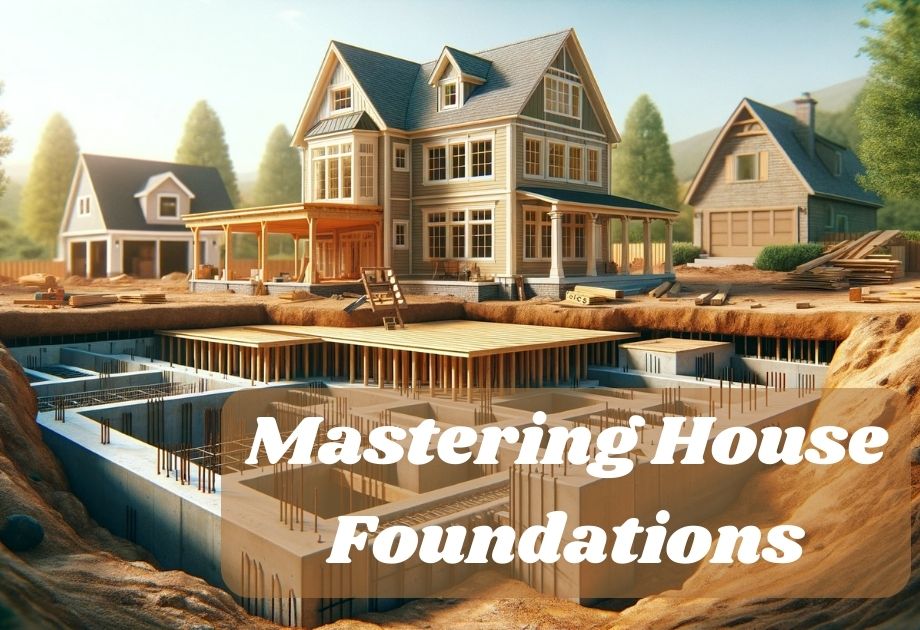The foundation of a home is much more than just the lowest part of the building; it’s the critical component that ensures the stability, safety, and longevity of the entire structure. Whether you call it a home foundation, house foundation, or building foundation, this fundamental aspect of construction serves as the bedrock upon which your home stands. In the grand scheme of building a house, the foundation is perhaps the most crucial element, setting the stage for the integrity of everything that comes above it.
What Does a Foundation Do?
A common question that arises in the realm of construction is, What does foundation do? The answer lies in the multifaceted role that a foundation plays. Primarily, it serves to transfer the load of the building safely to the ground, ensuring that the structure remains upright and stable over time. But its responsibilities extend beyond mere support. A well-designed foundation also acts as a barrier against moisture, insulates against cold, and resists the movement caused by soil expansion and contraction. In essence, the foundation is the unsung hero of your home, silently shouldering the burden of keeping your living space secure and comfortable.
In the following sections, we’ll delve deeper into the various types of house foundations, the process of building them, and the key considerations to keep in mind during construction. Understanding these elements is vital for anyone looking to build a new home or enhance the stability of an existing one.
Types of House Foundations

When considering the foundations for house construction, it’s important to understand that there are several types to choose from, each suited to different needs and environments. The most common types include:
- Slab-on-Grade Foundation: A single layer of concrete, several inches thick, laid directly on the ground. Ideal for warmer climates where the ground doesn’t freeze and cause the foundation to crack.
- Crawl Space Foundation: This type elevates the house slightly above the ground, protecting it from moisture and providing a small space underneath for utilities. It’s beneficial in damp climates.
- Basement Foundation: Typically found in colder climates, this deep foundation extends several feet below the ground, providing additional living or storage space.
- Pier and Beam Foundation: Consists of piers or posts that support beams or floor joists above the ground. This type is suited for sites with unstable soil conditions.
Each type of foundation has its unique benefits and challenges, and the choice largely depends on the local climate, soil type, water table level, and the homeowner’s needs and budget.
Building a Foundation: The Process
Building a foundation is a critical and detailed process that forms the first step in foundation building construction. Here’s a simplified step-by-step guide on how to build a house foundation:
- Site Preparation: The first step involves clearing and leveling the site for the foundation. This includes removing vegetation, rocks, and debris.
- Soil Testing: Before laying the foundation, it’s crucial to test the soil for its type and bearing capacity. This determines the foundation type suitable for the building.
- Design and Layout: Based on the soil test results, architects and engineers design the foundation layout, ensuring it can support the structure’s load.
- Excavation: The next step is to excavate the soil according to the foundation design. For basements, this involves digging several feet into the ground.
- Pouring the Foundation: Depending on the type, this can involve pouring concrete into molds for a slab foundation, creating footings for a crawl space or basement, or installing piers for a pier and beam foundation.
- Curing and Waterproofing: After pouring the foundation, it needs time to cure. Then, waterproofing measures are applied to protect it from moisture.
- Inspection: Finally, a thorough inspection is conducted to ensure the foundation meets all the required standards and specifications.
Building a foundation is a complex task that requires expertise and precision. It’s crucial to engage with professional builders and engineers to ensure that the foundation is structurally sound and built to last.
Key Considerations in Foundation Construction
In the domain of foundation building construction, several key factors must be carefully considered to ensure the foundation’s effectiveness and longevity. These factors include:
- Soil Type: The type of soil on your property plays a crucial role in determining the appropriate foundation. Soils vary in their bearing capacity, drainage properties, and potential to expand or contract, which can significantly impact the foundation’s stability.
- Climate: Climate heavily influences the choice of foundation. In areas with frequent freeze-thaw cycles, for example, foundations need to be constructed below the frost line to prevent damage. Conversely, in warmer climates, different considerations, such as heat and moisture resistance, come into play.
- House Design: The design and weight of your house also dictate the foundation type. Heavier structures may require deeper, more robust foundations to evenly distribute the weight and ensure stability.
- Local Building Codes: Compliance with local building codes and regulations is essential. These codes dictate specific requirements for foundation construction based on regional factors.
- Water Management: Effective drainage systems are critical to protect the foundation from water damage. This involves planning for proper grading, gutters, and downspouts to divert water away from the foundation.
Common Challenges in Building House Foundations
During the process of building foundation, several challenges may arise, impacting the integrity of the house foundation. These challenges include:
- Improper Soil Preparation: Inadequate compaction or incorrect handling of the soil can lead to uneven settling, causing cracks and structural issues.
- Water Damage: Without proper waterproofing and drainage, foundations can succumb to water damage, leading to mold, mildew, and weakening of the structure.
- Material Issues: The quality of materials used in foundation construction is paramount. Poor-quality concrete, for example, can compromise the foundation’s strength and longevity.
- Design Flaws: Inaccurate measurements or design errors can lead to significant issues down the line, such as misalignment or inadequate support.
- Unexpected Ground Movement: Shifts in the soil, whether due to natural causes or nearby construction, can affect the foundation’s stability.
At GWS Masonry, we understand these challenges and have honed our expertise to navigate them effectively. Our approach involves meticulous planning, adherence to industry standards, and use of high-quality materials to ensure a strong and durable foundation for your home.
Professional Insight: Why Expertise Matters in Building a Foundation
The role of professional expertise in building a foundation cannot be overstated. When it comes to laying the groundwork for your home, the knowledge and skill of experienced masons play a pivotal role. Here’s why professional guidance is crucial:
- Quality Assurance: Professionals like GWS Masonry ensure that the highest quality standards are met in every phase of the foundation building process. From selecting the right materials to executing precise construction techniques, expert masons guarantee a foundation that stands the test of time.
- Safety and Compliance: A professionally built foundation adheres to all safety norms and building codes. Expert masons are well-versed in local regulations and ensure that your foundation is not only robust but also legally compliant.
- Longevity and Durability: The longevity of your home directly depends on the strength of its foundation. Professional builders leverage their experience to construct foundations that can withstand environmental stresses and structural loads, ensuring the durability of your home.
- Risk Mitigation: Experts can foresee and mitigate potential risks associated with foundation construction, from dealing with unexpected soil conditions to addressing water management issues effectively.
Innovations in Foundation Building

The field of foundation building construction is continually evolving, with new trends and technological advancements enhancing the way foundations are built:
- Eco-Friendly Materials: The use of sustainable and environmentally friendly materials in foundation construction is on the rise, reducing the ecological footprint of building activities.
- Advanced Waterproofing Techniques: Modern waterproofing solutions offer superior protection against moisture and water damage, extending the life of foundations.
- Precision Engineering: The integration of technology like 3D modeling and computer-aided design in building foundation allows for more precise and efficient construction, reducing errors and saving time.
- Innovative Insulation Methods: New insulation techniques are being developed to improve the thermal efficiency of foundations, contributing to energy savings and enhanced comfort.
- Automated and Robotic Construction: Automation and robotics are beginning to play a role in foundation construction, promising faster, safer, and more accurate building processes.
At GWS Masonry, we stay at the forefront of these innovations, continuously updating our methods and practices to provide our clients with the most advanced and reliable foundation solutions.
Conclusion
In summary, the foundation of your home is far more than just the base upon which it sits. It’s the cornerstone of your home’s stability, durability, and overall safety. As we’ve explored in this article, from understanding the different types of foundations for houses to grasping the intricacies of foundation building construction, it’s clear that every aspect of a foundation demands careful consideration and expert execution.
The journey of building a foundation is filled with critical decisions that influence the longevity and integrity of your home. With the professional insights and innovations in the field, it’s evident that expert guidance is not just a luxury but a necessity. Whether it’s selecting the right materials, ensuring proper insulation, or employing the latest waterproofing techniques, each step in the foundation building process plays a vital role in securing the future of your home.
Remember, a well-constructed foundation not only supports your home today but also lays the groundwork for its resilience in the years to come. Trusting professionals like GWS Masonry with this pivotal task ensures that your home rests on a foundation of strength, quality, and expertise.
FAQ Section
Q: What are the main types of house foundations? A: The main types include slab-on-grade, crawl space, basement, and pier and beam foundations. The choice depends on factors like climate, soil type, and house design.
Q: How long does it take to build a house foundation? A: The time to build a foundation varies depending on the type and complexity. On average, it can take anywhere from a few days to several weeks.
Q: Can foundation issues be fixed? A: Yes, many foundation issues can be repaired, though the ease and cost of repairs depend on the severity of the problem. Early detection and professional assessment are key.
Q: Is waterproofing a foundation necessary? A: Absolutely. Waterproofing is crucial to protect your foundation from moisture-related issues like mold, mildew, and structural damage.
Q: How often should a foundation be inspected? A: It’s advisable to have your foundation inspected at least once every few years, or more frequently if you notice any signs of damage or issues.
By addressing these common queries, we reaffirm the importance of each aspect of foundation construction and maintenance, further solidifying the foundation of knowledge for homeowners and builders alike.


Leave a Reply